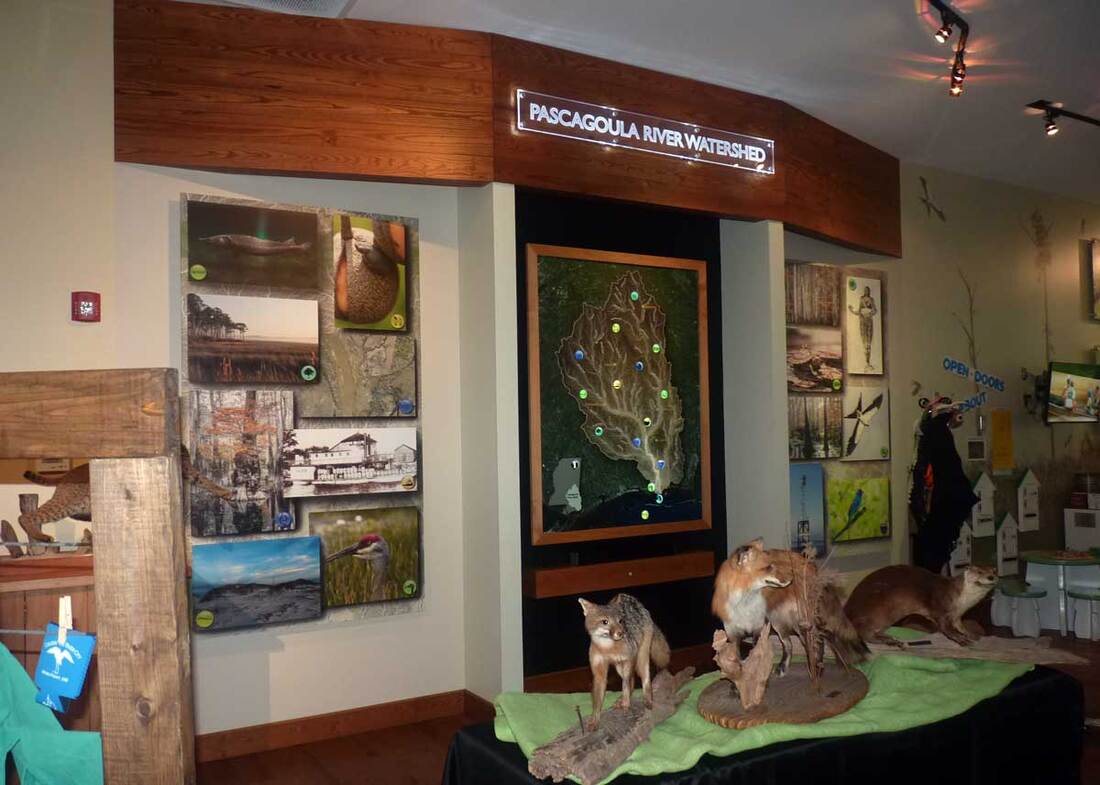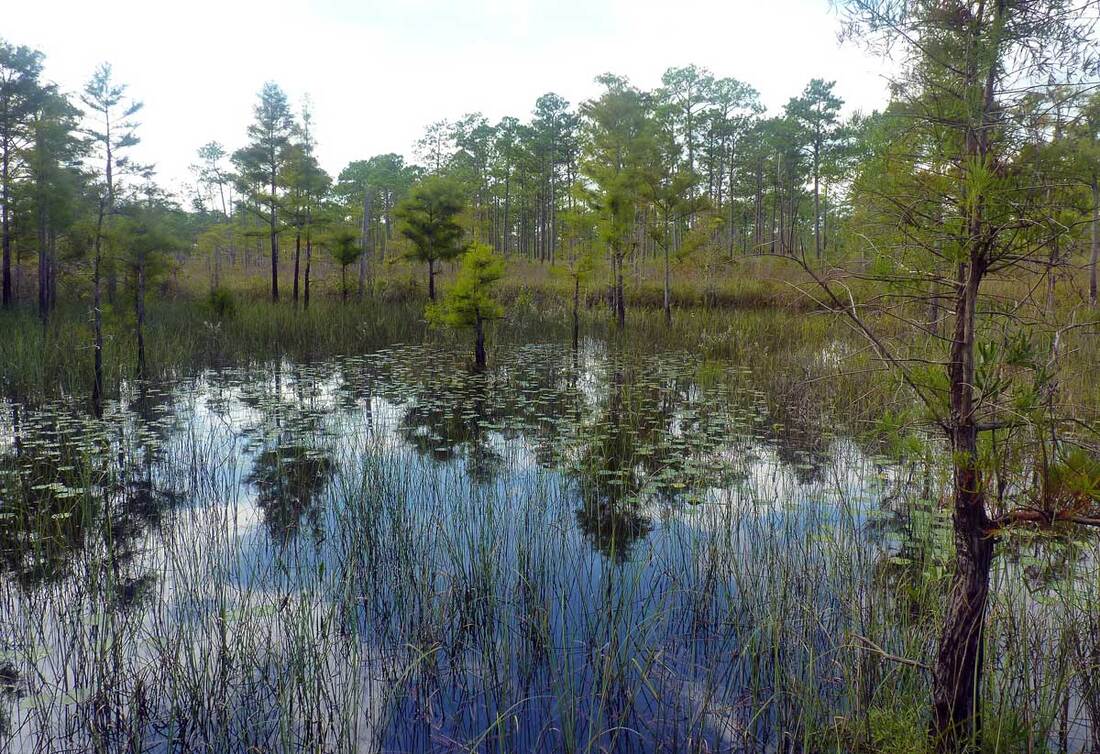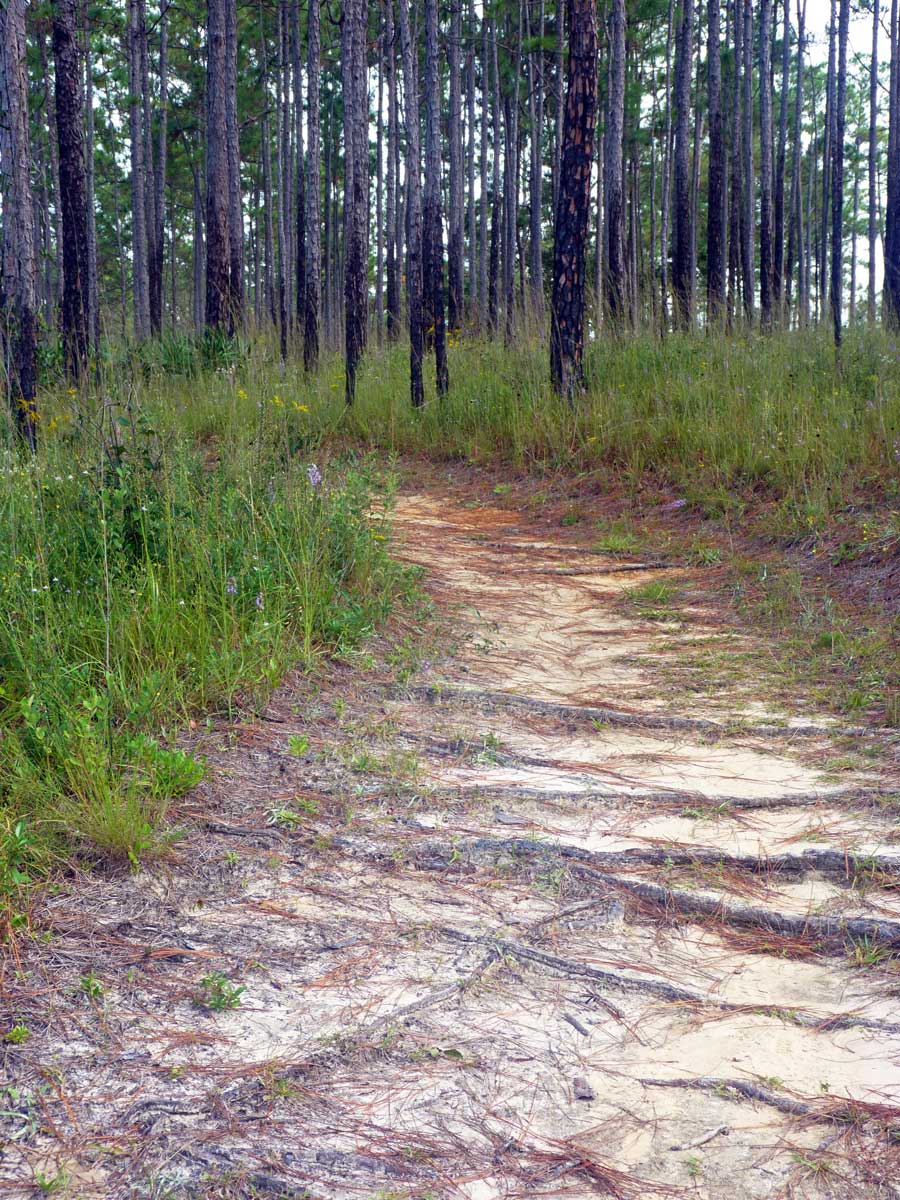Autumn is perhaps the best season to appreciate the beauty and environmental significance of coastal Mississippi, and some of the unique places – and wildlife – that make our area special.
- story by Dena Temple - photos by Dena Temple (unless otherwise attributed)
East of Gulfport and Biloxi we traverse a 4-mile elevated roadway over the Pascagoula River delta. Below is the largest undammed river in the lower 48 states. In 1974, the Nature Conservancy and other conservationists rallied to bring 35,000 acres of the Pascagoula River watershed under public protection. This led to a river corridor presently buffered by almost 70,000 acres of public and private conservation lands. The Nature Conservancy today continues to monitor and maintain the condition of the Pascagoula River Watershed for wildlife and future generations (read more about their conservation efforts here). Just beyond the elevated roadway is Exit 68 for Moss Point. A brown sign confirms that this is our exit for the Pascagoula River Audubon Center, just a few minutes down the road. Pascagoula River Audubon Center
Their small parking area is bordered by a fence hand-decorated with egrets welcoming visitors to the center. It’s lovely, but more interesting is the unusual pavement in the parking lot. A grid of black plastic circles keeps the pea gravel paving material at bay. An interpretive sign provides fascinating information on the use of this and other “pervious” or permeable paving materials, which help reduce runoff and allow the groundwater to recharge. Our lessons begin here in the parking lot!
The Center is located on Rhodes Bayou, which drains into the Escatawpa and Pascagoula Rivers. Exhibits focus on the ecosystem of the Pascagoula River watershed, and the site extensively uses native plants, removes invasive species, and incorporates structures for wildlife. If you have or want a home wildlife garden, you’ll find plenty of inspiration here.
The leisurely stroll from the parking area to the Center leads us down a former trolley path of the Pascagoula Street Railway & Power Company, which ran from 1900 to 1925. Today, a replica of the trolley line ticket booth contains historic information about the trolley and the area’s lumber history. Further down the path is a “Nature Play” garden, where children ages 8 and under get to explore the natural world through play. Under a large oak, we find Center educator Suzie Trott conducting “Toddler Tuesday.” She is surrounded by about 15 little ones and their grownups. The kids are shy at first but by the end of story time, most are yelling out questions and squealing with delight at every right answer. The weekly program, geared toward children ages 1-4, includes a science lesson, a story, and playtime to connect the youngsters with nature. Atop a flight of stairs is the Center. Just four years old, the striking, elevated wood structure features front and back “porches” with comfy rockers. The porches overlook marshland and meadow, and time spent in a rocker enjoying the sounds of nature must be very pleasant, indeed. The rockers were made possible by donations from local families and businesses. Just inside the double doors is a welcome desk and the smiling face of Andrea Belcher, Outreach and Facilities Associate. Her job this morning is answering questions for visitors, but she is also responsible for managing the Center’s art gallery. The gallery, which features exhibits that change every six weeks, currently features “Extreme Elements: Earth, Wind, Fire, Air.” Artists’ receptions are held to allow the public to meet the artists. The gallery (and the entire facility, for that matter) can be rented for weddings or other special events. Center manager Susan Stachowski oversees daily operations at the Center and develops programs and activities for nature lovers of all ages. She is particularly proud of the Center’s programs for children. “In season, our Children’s Garden really connects kids with the outdoors,” she explains. “They plant the seeds and watch the plants grow. A few weeks ago they dug up potatoes. They were amazed that potatoes came from the ground!” Another of Susan’s programs also is geared toward attracting younger enthusiasts, but in a slightly different way. “Our hummingbird festival was a great success,” she says, “especially Hummingbird Happy Hour. Through social events like this, and our quarterly Birds and Brews meetup, we hope to engage young adults and get them involved in birds and conservation.” Like many birdwatchers, Susan is clearly hummingbird-crazy, as evidenced by the 22 hummingbird feeders behind the Center. The Center also features a gift shop with the usual assortment of field guides, t-shirts and stuffed animals. Of note are beautiful bird houses made by local artist Pete Floyd, whose work can be seen at the Peter Anderson Arts Festival in Ocean Springs (Nov. 2). Other exhibits inside the Center’s main room include aquariums containing turtles, snakes and other small animals; several taxidermy exhibits, including a bobcat; a children’s play area; and an engaging Pascagoula River Watershed diorama. The lower level of the Center (outdoors) features a picnic area (which can also be rented), a children’s garden, nature trails through a hummingbird garden and wildflower meadow, a boardwalk through wetlands, and a dock and observation platform on Rhodes Bayou. Water activities include kayak rentals and a two-hour boat tour for $30 (run by a private operator; reservations required).
After thanking Susan for her wonderful tour of the Pascagoula River Audubon Center, we set out on a peaceful 20-minute bird walk on the property and casually discover 17 species of birds, including Bald Eagle, White Ibis, Anhinga and Summer Tanager. Wow! Lunch with a "B"
Two excellent options exist for lunch after a morning at the Pascagoula River Audubon Center, and the first is just around the corner. Our first “B” is Burnham Drugs, located at 5001 Main Street. This was a recommendation from Susan Stachowski at PRAC. “It’s an old-fashioned soda fountain,” she explained, “and the food is great. They have burger specials on Tuesdays, too!”
From the outside, one would never know that food was being served inside this drug store, so this is a true “hidden gem.” The windows of Burnham Drugs show a nice assortment of gift items, consistent with what you would expect to find in a large pharmacy. But the front doors might as well be a portal to the past, because inside is a true ‘50s luncheonette / soda fountain. Stools wrap around a curvaceous counter over black-and-white checkerboard floors; here, patrons pass the sugar and the local gossip. If diners are lucky enough to score one of the five booths, they are treated to a tasty breakfast, burgers, hot dogs or milk shakes. The only thing missing is a gum-cracking waitress. But – curses – today the counter and booths are filled to capacity, so it’s on to the other Plan “B.” About ten minutes’ drive from PRAC is Bozo’s Seafood Market, located at 2012 Ingalls Avenue in Pascagoula. Its dreary, grey exterior belies what waits inside; only the endless cars coming and going like worker ants at an anthill give any indication that something great is happening inside. Once through the doors, though, Bozo’s goes from drab to a cheery yellow, and the fun begins. A friendly cashier at the door guides new patrons to the order counter, which is fairly well hidden in the back of the restaurant next to the pickup window. Options include a long list of poboys, sandwiches, dinners, baskets (fried or steamed), homemade gumbo and salads. Shrimp in all its forms is the order of the day – after all, this is shrimpin’ country, and what diners are eating today was swimming yesterday. You really can’t make a mistake here; Bozo’s is recognized as one of the top 15 seafood restaurants in Mississippi, and one of the top 20 seafood dives in the country. Once an order is placed, diners return to the friendly cashier, order drinks and pay the tab. Then it’s time to snag a table and wait for your name to be called. There are a few conventional hi-top tables along the far wall, but most patrons opt to sit at the long tables in the center. These unique tables have saw-cut holes every few feet, so diners can peel-and-eat their luscious shrimp, then toss the shells away down the holes.
In the back of the restaurant is a clean, well-lit seafood market, where patrons can order shrimp for the next big game either raw or steamed to order. There are lots of fresh fish, whole and fillets, for sale as well. Over the pickup window is a one-of-a-kind, handmade sign advertising their signature poboys. For those who like folk art advertising, this sign is the real deal.
After grabbing the Styrofoam-wrapped goodness at the pickup window, the peeling and feasting begins. Prices are reasonable and portions are huge, and no one leaves Bozo’s hungry. For example, the steamed shrimp basket ($9) includes a mound of (plain, mild or spicy) shrimp, corn on the cob, sausage, potatoes and cole slaw. Fountain drinks can be refilled as needed. Once you’re satisfied, a quick trip to the rest room is needed to wash away all evidence of the unbridled gluttony that just took place. Now it’s off for our afternoon adventure. Mississippi Sandhill Crane National Wildlife Refuge
Heading west on I-10 from Bozo’s Seafood Market, it’s just a few miles to the entrance of the Mississippi Sandhill Crane National Wildlife Refuge. The entrance road winds its way through longleaf pine savannah to a modest visitor center.
A ranger volunteer is ready at the entrance with a greeting and an introduction to the refuge with a 12-minute movie on the history of the region and the importance of the refuge. After that giant lunch, resting while watching a movie sounds pretty great. There are six subspecies of Sandhill Cranes in the United States; three are migratory, and three are non-migratory. The Mississippi Sandhill Crane is non-migratory and is therefore dependent on finding suitable habitat for food and nesting. It found that habitat, the wet, longleaf pine savannah, along the Mississippi Gulf Coast. Over time, these prairies of grass and pine have been lost to man-made pine forests for logging, and clearcutting for residential development. So much habitat was lost - in fact, only 3% of the original wet pine savannah remains – that by the early 70s, the Mississippi Sandhill Crane population plummeted to just 30-35 individuals. In the mid-70s, World War II veteran and National Park Service wildlife biologist for the Gulf Coast Region Jake Valentine, Jr. started a movement to preserve the savannah habitat for the Sandhill Cranes. In fact, the Mississippi Sandhill Crane was one of the first species to be protected under 1973’s Endangered Species Act, and this 20,000-acre Refuge was the first to be created under the Endangered Species Act in 1975. This is the last parcel of wet pine savannah in the region. The protection of this important habitat, along with human help with improving reproductive success, has grown the Sandhill Crane population to around 100 birds. In fact, most of the current population were either hand-raised or descended from hand-raised birds. Still, their low numbers give the Mississippi Sandhill Crane the dubious distinction of being the rarest bird in North America.
The ranger tells us that, while Sandhill Cranes are usually not seen at the Visitor Center, two birds were spotted in the fields earlier in the day. (If you like to bird-watch, you’re used to the phrase, “You just missed it!”) Park rangers lead guided tours into the Refuge to areas where the cranes can be seen; these tours are held Wednesdays and Saturdays November through February. He also shares that the refuge winters about twenty percent of the world’s population of the secretive Henslow’s Sparrow. There are short nature trails near the refuge headquarters which meander through some of the denser areas of pine, grasses and wildflowers, past a bluff overlooking Bayou Castille. Beautiful vistas reveal themselves around every bend, especially as the sun lowers in the sky and shadows lengthen in the late afternoon.
The Visitor Center closes at 3 pm but the park is open until dusk, so we continue our walk. Birds and butterflies scoot past, and little by little, attention turns from the wide vistas to the details at hand: beautiful plumes of grass with pink, smoke-like tassels that wave in the wind; wildflowers like asters, blazing star and narrowleaf (or swamp) sunflowers; the carnivorous pitcher plant; and tiny butterflies that flutter by.
It is then, when the silence is only broken by the rattle of the grasses in the wind, that one can imagine hearing the wingbeats of a butterfly, or the shrill trumpeting of a Sandhill Crane in the far distance.
As the trail ends and the day grows old, birds become more active. Bluebirds cavort and chase insects. Brown-headed Nuthatches pull seeds from the cones on the pines. A lone Palm Warbler bobs its tail and flits about. And a Blue Jay imitates the call of a Red-shouldered Hawk, for no reason other than, it can. Comments are closed.
|
Categories
All
Archives
July 2024
|
Shoofly Magazine Partners
Our Shoofly Partners are local businesses and organizations who share our mission to enrich community life in Bay St. Louis, Waveland, Diamondhead and Pass Christian. These are limited in number to maximize visibility. Email us now to become a Shoofly Partner!




























































 RSS Feed
RSS Feed























